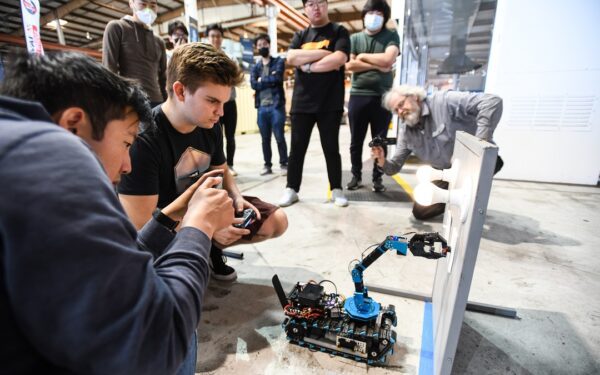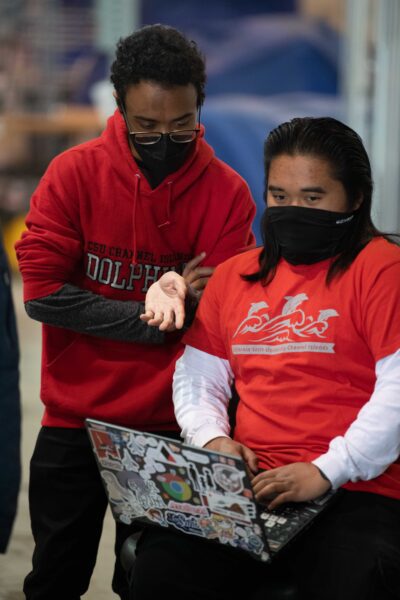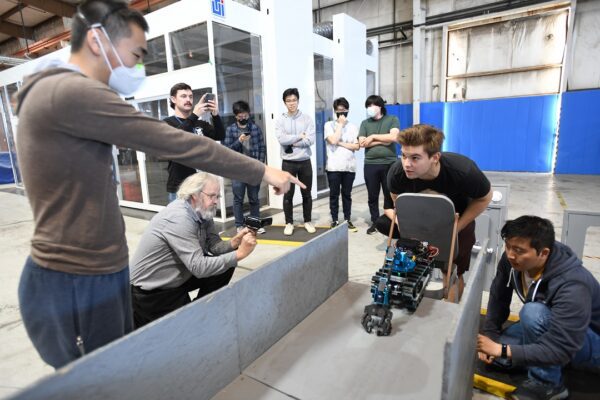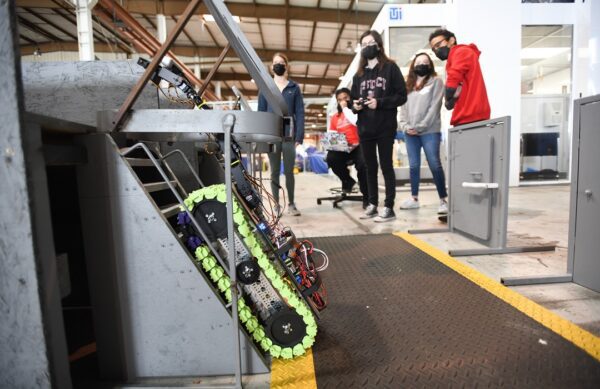By Thomas McMahon, NSWC PHD Public Affairs
Could a robot work its way through the heavy doors, steep stairways and tight corridors of a Navy ship to potentially alleviate Sailors of repetitive maintenance tasks?
Local college students sought to answer that question as they brought robots they had designed to navigate a ship-model obstacle course in Naval Surface Warfare Center, Port Hueneme Division’s (NSWC PHD) first Robot Rodeo competition, held May 19 and 31 at the command’s Fathomwerx Lab at the Port of Hueneme in Port Hueneme, California.


Two teams of students — one from California State University Channel Islands (CSUCI) in Camarillo, California, and one from University of California, Santa Barbara (UCSB) — spent months building remote-controlled vehicles with crawler tracks and robotic arms to take on the obstacle course, which replicated features of the NSWC PHD’s Self Defense Test Ship at one-third scale. The test ship is a decommissioned warship that can be remotely operated for testing weapons systems without risk to the ship’s crew.


To complete the course, which U.S. Naval Academy interns designed at Fathomwerx last summer, the students’ robots would have to open a hatch door and move through it (clearing the “knee-knocker” bottom portion of the frame), ascend a stairway, turn twice through a corridor, descend another stairway, open and pass through another door, and then turn on two light bulbs with different types of switches.


But robotic technology can be unpredictable. The CSUCI team’s robot experienced technical problems when it was time to compete, but the students worked through them and ultimately completed all but one obstacle. The UCSB robot got off to a quicker start and tackled the full course.
Robotic research
The Robot Rodeo stemmed from an objective that the Naval Sea Systems Command (NAVSEA) Technology Office assigned to NSWC PHD. As Greg DeVogel, chief technology officer for NSWC PHD, explained, the Navy is interested in whether robots could be developed to conduct routine maintenance and other tasks aboard ships while moving around on their own.


“NAVSEA’s Technology Office gave us the problem to solve, which is, ‘How does a robot get through a ship?’” DeVogel said. “The ship ladders are very steep, and the doors can be very hard to open. The amount of pressure you need to open the doors can be up to 70 Newtons, which is a lot of force.”
A robot strong enough to open such doors would cost about $100,000, DeVogel said, which is why NSWC PHD held the first Robot Rodeo on a miniature obstacle course at Fathomwerx instead of on the actual Self Defense Test Ship. This enabled the local universities to participate, because the smaller scale course only required a robot that could be built for about $5,000 from a kit.
The National Security Innovation Network (NSIN), an Arlington, Virginia-based problem-solving network within the Department of Defense (DOD), provided funding for the universities to take part in the Robot Rodeo.
“There’s no cost to our command, and we get free looks at what technology works better and what doesn’t work as well,” DeVogel said.
NSIN helps develop new technologies and capabilities by working directly with early-stage startups and academic institutions.
“Universities across the country are filled with creative minds willing to work on DOD challenges,” said Jesse Gipe, Pacific-south regional director at NSIN. “Through NSIN programming efforts, we seek to connect those problem solvers with DOD components willing to pursue creative solutions. The Robot Rodeo challenge developed by the excellent team at NSWC PHD is exactly the type of effort we support.”
Alan Jaeger, manager of NSWC PHD’s Office of Research and Technology Applications and director of the Ventura Tech Bridge at Fathomwerx, added that the Robot Rodeo ties in with the command’s strategic efforts to create a culture of innovation to deliver and sustain capability to the Navy fleet.
“This is a great opportunity to facilitate innovation as we engage with students,” Jaeger said.
Connecting the dots
For the students, the Robot Rodeo helps put their education into practice, according to Jason Isaacs, a CSUCI professor of computer science, information technology and mechatronics, which is a multidisciplinary branch of engineering that includes robotics.
“This is a way for us to present students with an open-ended problem that requires creative solutions,” Isaacs said, as his students readied their robot for the obstacle course at Fathomwerx. “It also requires them to basically piece together all the things they’re learning about in various classes and see how they all come together to actually make something.”
For some students, the Robot Rodeo served as a capstone project to culminate their studies in their senior year of college. That’s one of the objectives of the Problem-based Initiatives for Powerful Engagement and Learning in Naval Engineering and Science (PIPELINES) program, which Doug Bradley coordinates at UCSB.
Bradley, also a lecturer at the university, said that students benefit from the mentoring that NSWC PHD and other local commands provide through PIPELINES projects like the Robot Rodeo, and the Navy can benefit from the students’ new ways of thinking.
“The Navy presents a great opportunity for the students to work with seasoned civilian engineers to solve real-world questions that the Navy is interested in,” Bradley said. “And one of the great things about having undergraduates work on a project like this is they don’t know what’s not possible—they have a completely unbiased, fresh perspective.”
Another advantage of the Robot Rodeo is that it adds to NSWC PHD’s outreach efforts to promote careers in the science, technology, engineering and mathematics fields. On that front, at least three students from CSUCI and UCSB who participated in the Robot Rodeo have accepted jobs or internships at NSWC PHD or another local Navy command.
One of the incoming employees is Sean Jau, a UCSB mechanical engineering major, who is slated to join NSWC PHD’s Air Dominance Department this summer. He said that visiting naval vessels like the decommissioned aircraft carrier USS Midway sparked his interest in working for the Navy.
“I really like warships—there’s just something majestic about them,” Jau said.
Overcoming obstacles
Once the CSUCI team got its robot running, the students used a wireless Xbox controller to move the robotic vehicle through the ship-model course. The vehicle succeeded on all but one of the obstacles—descending the staircase—and completed the course within the 10-minute time limit.
On May 31, the UCSB team’s robot, dubbed Gravy, started the course without issue. Also operated by remote control, Gravy moved through the first door and up the stairs. As the robot rounded a corner to descend the stairs, the team turned it backwards, taking advantage of a tail-like appendage the students had installed on Gravy so it could back down the steep stairs—like humans usually do—without issue.
As Gravy flipped on the second light switch to finish the course, Jaeger called out the time—9 minutes, 53 seconds. With seven seconds to spare, the UCSB students had succeeded on all of the obstacles, earning them the win. Their prize: a Robot Rodeo trophy, custom-made on Fathomwerx’s 3D metal printer.
NSWC PHD plans to host another Robot Rodeo next year. DeVogel said that the second edition may expand in scope, potentially inviting industry partners to participate, but depends on NAVSEA 05’s requirements.
NSWC PHD is a field activity of Naval Sea Systems Command and provides the U.S. Navy fleet with in-service engineering, test and evaluation, and product support for combat systems. The command is located at Naval Base Ventura County in California and oversees the Naval Agility (NavalX) Ventura Tech Bridge, which encompasses Fathomwerx Laboratory in partnership with the Port of Hueneme and other associates. The Ventura Tech Bridge is one of 18 technical regions for the Navy worldwide, established to connect industry, academia and stakeholders with the U.S. Navy’s NavalX network of partners.
TELL YOUR FRIENDS ABOUT CITIZENS JOURNAL Please keep us publishing – DONATE



